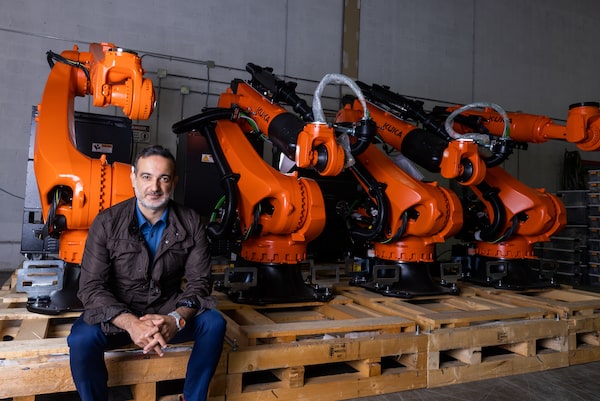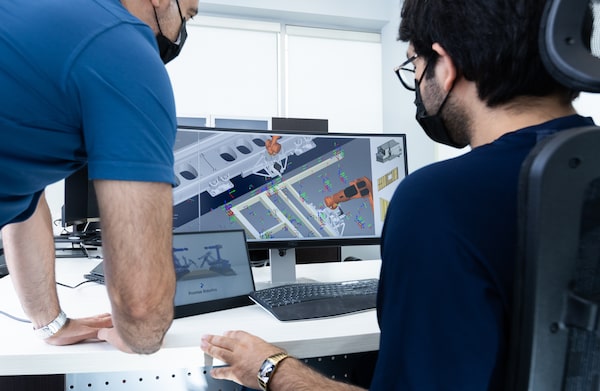
Promise Robotics CEO Ramtin Attar with a few Kuka Industrial robots similar to ones fitted with custom tooling developed by Promise Robotics to perform complex construction tasks.Glenn Lowson/The Globe and Mail
Robots constructing homes may sound like science fiction. Yet a Toronto-based startup aims to make this futuristic idea a reality within the next year, leveraging advances in automation, advanced manufacturing, cloud computing and artificial intelligence (AI).
Promise Robotics was launched in 2019 by founders Ramtin Attar – a former technology lead at a multinational technology company – and Reza Nasseri, the chief executive officer of Landmark Homes.
The technology company, which also has operations in Edmonton, seeks to bring emerging technologies to the home building industry to address the industry’s biggest challenge: meeting the rising demand for housing amid a growing shortage of affordable homes.
“Our vision is really centred around using new technologies enabling the industry to be better,” says Mr. Attar, CEO of Promise Robotics and former head of technology pathfinding at Autodesk, the world’s leading provider of software for architecture, engineering, construction and manufacturing.
“At the core ... we are dealing with an industry that is the second least digitized, yet it has such importance to our lives.”
While finance and manufacturing have embraced computer technology, radically altering their operation, the construction industry has fallen behind using emerging technologies, including robotics and AI.
“When we measure it at the industry level, it’s really lagging in terms of productivity, and when you add other considerations like affordability … We felt the industry was ready for disruption,” Mr. Attar says.
In particular, productivity in construction has fallen behind other industries, a 2017 report by McKinsey Global Institute found. It notes the industry’s labour-productivity growth averaged 1 per cent annually over the past 20 years. By comparison, manufacturing productivity grew by 3.6 per cent.
The report goes on to argue that by embracing new technologies, the construction industry could add US$1.6-trillion – 2 per cent of the global economy – to the US$10-trillion in economic activity it generates.
In Canada, the construction industry creates about $141-billion in economic activity annually, employing 1.4 million people, Canadian Construction Association figures show.
Yet, the country and industry face two challenges: a shortage of affordable housing and of skilled labour.
A recent Scotiabank report highlighted that Canada has the lowest number of housing units per 1,000 residents of any G7 country. Since the pandemic, demand for housing, especially single-family homes, has accelerated with mortgage rates at historic lows amid lagging supply, leading to declining affordability, the report notes.
At the same time, the industry has struggled to keep up, lacking skilled workers, which will only get worse, a 2021 report by BuildForce Canada states.
Despite construction employment demand forecast to grow by 6 per cent by 2030, a quarter of a million people in the current work force are expected to retire. Training and funding for it will undoubtedly be important, but companies such as Promise Robotics offer near- and long-term solutions to both problems.
“We’re now at a point where this is a massive problem,” says Salim Teja, partner at Toronto-based Radical Ventures, one of the world’s largest AI-focused venture funds.
“Projects take longer because of difficulties with access to work force … and there is a really antiquated process of construction, which means we can’t get supply to market fast enough.”
Radical Ventures, an early-stage investor in Promise Robotics, views the company as a potential answer to both challenges.

Mr. Attar, left, and research intern Ali look over Promise Robotics' robot programming software.Glenn Lowson/The Globe and Mail
So just how does the small startup intend to use robotics and AI to address them?
Promise Robotics puts a new spin on modular construction – already a growing home-building method.
Rather than relying on some automation (i.e. robotic machinery) and human capital, Promise Robotics is building an entirely automated factory that can manufacture wood-frame single-family home or condominium components, walls and roofs, which can be shipped easily to the project site for rapid assembly.
Central to its thesis is AI, creating smart robots capable of doing more than one task, such as repeatedly cutting lumber.
“Robots are just machines, so you need software to make them intelligent,” Mr. Attar says.
Instead, these machines can learn many tasks, able to pick out and grab materials, size and cut them, and then assemble the pieces into a wall.
Another important aspect of Promise Robotics is that its factories will be scalable, featuring to start two large robots that “can make lots of decisions” run by cloud-based software, allowing these facilities to operate remotely, close to construction sites, which is especially beneficial for home building in remote areas where housing is scarce, he adds.
Mr. Teja says the company is in a unique position to disrupt the industry using AI because many advances in the field were developed in Canada.
“We have a really good reputation globally for being leaders in AI.”
While Toronto and Montreal are notable hubs for research and related startups, Edmonton is another important centre, especially for a specialized AI called machine reinforcement learning.
While deep learning involves a robot, for instance, using machine learning to acquire the ability to do tasks and then apply that to do slightly new tasks, reinforcement learning is a “methodology where the robot is given a task and it understands if it succeeds or fails,” Mr. Teja explains.
In short, it can learn through trial and error, he adds.
Much of the fundamental research for this type of AI was done by Richard Sutton, a University of Alberta computer scientist. His team’s work, in turn, parlayed into the formation of the Alberta Machine Intelligence Institute (AMII) in Edmonton, which has been a source of talent, research and support for Promise Robotics.
Already, the company has an early-stage factory that should be able to build components later this year. When fully developed, Mr. Attar says the advanced manufacturing platform will be able to build homes significantly faster, leading to as much as a 40-per-cent cost savings over current methods.
For a single-family home, for example, “traditional framing would take three to four people three or four weeks, depending on complexity,” he says. “We are aiming to do the same in about a day or two.”
It’s an enticing technology, says Thomas Strong, president of CanBIM, a not-for-profit promoting technology and innovation in construction.
“A lot of big general contractors in Canada have made significant investments in off-site construction, and they are moving in that direction.”
But the challenge with these technologies is scaling them to the point where their high cost of adoption makes them economical. He notes automation has been more easily incorporated in the auto sector, for example, because “you start making money at the one-millionth product that comes off the assembly line.”
That scale does not exist even in residential construction. Yet, Mr. Attar says Promise Robotics aims to make using its technology cost-efficient because its factories are flexible, able to serve smaller builders and pivot from building a single-family home to a condominium.
“We can have much smaller, agile systems that are easy to set up and don’t require a lot of infrastructure,” he says.
“You can take a small warehouse, set it up and start building components.”
Much remains to be fleshed out for the startup regarding its technology, given the complexity involved for even basic tasks – such as training a robot to put a new cartridge in a nail gun. If successful, however, Mr. Attar says the technology could be exported, as could prefab home components manufactured in Canada to meet not just domestic, but global demand.
“It’s a complete rethink of how you design and build homes,” he says. “When we talk about the big innovation stories for Canada, these are the game-changers we want to develop.”